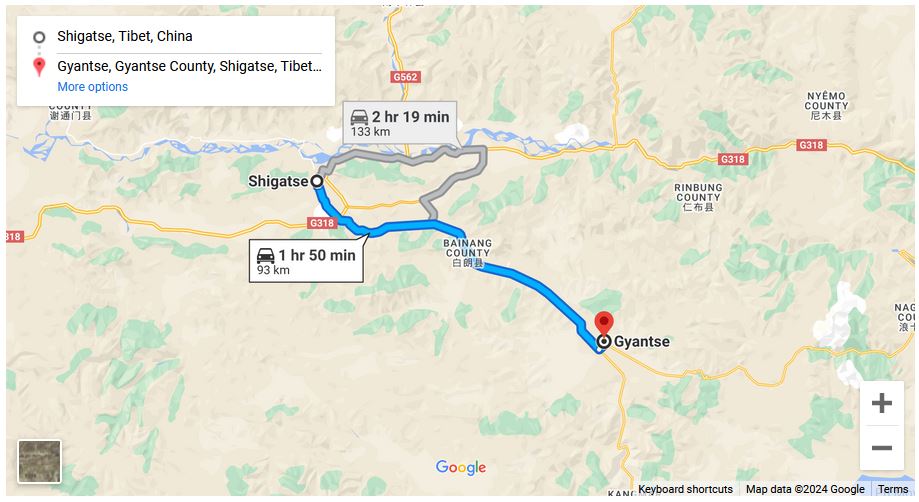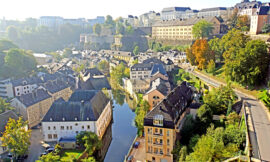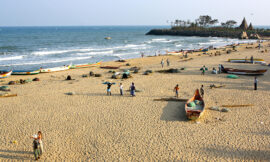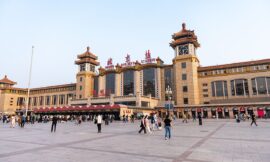The journey from Shigatse to Gyantse is a captivating exploration of Tibet’s cultural and historical tapestry, as travelers traverse the high-altitude landscapes and traditional Tibetan towns that define this region. Departing from Shigatse, the second-largest city in Tibet, the road to Gyantse unveils monastic treasures, ancient fortresses, and the timeless allure of the Tibetan Plateau.
Shigatse, situated at an elevation of around 3,800 meters, is home to the iconic Tashilhunpo Monastery, a major center of Tibetan Buddhism. The journey begins with a visit to this monastic complex, where travelers can explore ancient prayer halls, marvel at towering statues, and soak in the spiritual ambiance that permeates the monastery grounds. The Tashilhunpo Monastery, founded by the first Dalai Lama in 1447, stands as a testament to Tibet’s rich religious and cultural heritage.
Leaving Shigatse behind, travelers embark on the road to Gyantse, a journey that unveils the vast plateaus and snow-capped peaks characteristic of the Tibetan Plateau. The road offers panoramic views of the Himalayan ranges, providing travelers with a sense of the immense scale and beauty of the high-altitude landscapes. En route, nomadic herders with their yaks and traditional black tents add to the authenticity of the Tibetan plateau experience.
As the road winds through the arid terrains, travelers often encounter the serene waters of Yamdrok Lake, one of Tibet’s three largest sacred lakes. The turquoise expanse of the lake, surrounded by prayer flags and overlooked by snow-capped peaks, creates a breathtaking spectacle against the stark backdrop of the plateau. Yamdrok Lake holds deep spiritual significance, and its tranquil beauty adds a sense of reverence to the journey.
The road then leads to Gyantse, a historic town that has played a pivotal role in Tibet’s cultural and political history. Gyantse’s most notable landmark is the Pelkor Chode Monastery, which houses the iconic Kumbum Stupa. The Kumbum, a multi-tiered structure adorned with exquisite murals and sculptures, is a masterpiece of Tibetan art and architecture. Travelers exploring the Pelkor Chode Monastery are immersed in the rich religious and artistic traditions of Tibet.
Gyantse also boasts the Gyantse Dzong, a medieval fortress that once served as a strategic military stronghold. The fortress, perched on a hill overlooking the town, offers panoramic views of the surrounding landscapes and the quaint streets of Gyantse below. Exploring the Gyantse Dzong provides insights into Tibet’s historical fortifications and the challenges faced by ancient Tibetan kingdoms.
The town’s charming streets, traditional architecture, and vibrant marketplaces allow travelers to experience the authentic rhythms of Tibetan daily life. Gyantse’s cultural richness, coupled with its serene surroundings, makes it a captivating stop along the journey through Tibet.
Accommodations in Gyantse range from traditional Tibetan-style guesthouses to modern hotels, offering travelers a comfortable and authentic stay. The town’s eateries provide a taste of Tibetan cuisine, allowing travelers to savor the unique flavors of the region.
In conclusion, the road from Shigatse to Gyantse is a passage through the heart of Tibet, unveiling monastic treasures, ancient fortresses, and the sublime landscapes of the Tibetan Plateau. From the spiritual ambiance of the Tashilhunpo Monastery in Shigatse to the cultural richness of Gyantse with its Pelkor Chode Monastery and Gyantse Dzong, the journey is a testament to Tibet’s enduring heritage. Gyantse, with its historical significance and timeless charm, invites travelers to delve deeper into the cultural and historical tapestry that defines this region of the world.



